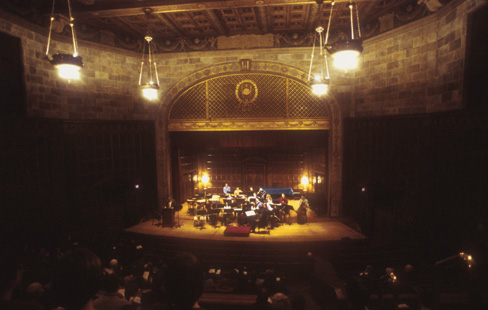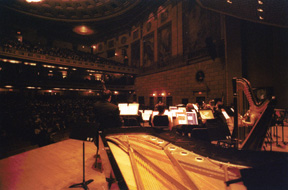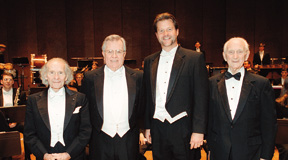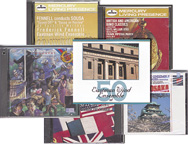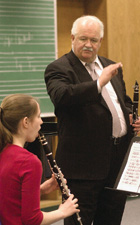![[NEWS AND FACTS BANNER]](/URClipArt/news/titleNewsFactswide.jpg) |
||||||||||||||||
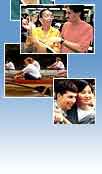
|
||||||||||||||||

Golden Harmony
The Eastman Wind Ensemble's alumni, current players, and conductors - past, present, and future - celebrate the famed group's 50 years of leadership in classical music. By Jeffrey Marsh On a cold Sunday in February 1953, a small group of Eastman students took to the stage of Kilbourn Hall for their first performance as the Eastman Wind Ensemble. Under the direction of Eastman professor Frederick Fennell '37E, '39E (MS), '88E (HNR), the new group's renditions of Mozart and Richard Wagner impressed a sizeable crowd.
Fifty years, dozens of recordings, a touring schedule that has circled the globe, and three conductors later, those same compositions - Mozart's Serenade No. 10 in B-flat, Wagner's Elsa's Procession to the Cathedral - again echoed from oboes, trombones, and clarinets on stage at the Eastman School of Music. What a difference a half century can make. A near-capacity audience crowded into the much larger Eastman Theatre to hear the ensemble's gala concert and to celebrate the group's golden anniversary. The performance capped a five-day wind ensemble conference attended by many alumni players as well as conductors and performers from around the world, showcasing Eastman's influence in shaping a genre that did not exist 50 years ago. The ensemble's three conductors-Fennell and his successors, A. Clyde Roller and Donald Hunsberger '54E, '59E (MM), '63E (DMA)-each received long standing ovations during the gala performance as much for the role they played in the group's history as for the performance itself.
The celebration also marked the passing of the baton from 37-year conductor Hunsberger to Mark Scatterday '89E (DMA), who will take over the ensemble in July. As a student, Hunsberger was a member of that first group 50 years ago. A trombonist with the ensemble, he described the music of that first concert as "first rate." "I have little recollection that anyone had any idea that this first program was to eventually lead to the ensemble's being the leading model for the wind ensemble concept over the succeeding 50 years," he says. But the succession of concerts and tours, recordings, and commissioned work helped spread the ensemble's reputation and sparked countless similar groups. So it was only fitting that former players and specialists from around the country returned to celebrate its anniversary. "The highlights were the performances by the students," says Hunsberger. "We had all worked very hard to make this a wonderful event." In addition to reprising the debut concert bill, the ensemble was joined by the percussion (and alumni-filled) group Nexus for a tumultuous work by Karel Husa titled Concerto for Percussion and by Eastman professor and pianist Barry Snyder for Verne Reynolds's Concerto for Piano and Winds, a work commissioned for the ensemble in 1996. The group also performed the world premiere of a newly commissioned work, Pulitzer Prize-winner Bernard Rands's Unending Lightning. Featuring seminars on improvisation, rehearsing, and wind orchestration as well as performances by the Eastman group, the Ithaca College Wind Ensemble, and the U.S. Military Academy Band, the conference underscored Eastman's leadership in developing the wind ensemble as a unique kind of performance group. The Eastman Wind Ensemble has been on the cutting edge as far as developing the repertoire and playing new pieces from the beginning," Hunsberger says. "This group is so well known that our standards are out on display for all time." For some student members of the ensemble, an impromptu performance with both current and former players and all four conductors the day after the gala concert was the real highlight. "The most fun was playing with the alumni," says trombonist Mike Selover '02E. "You think about what they've done after graduation and how important they were to wind ensembles, and it's pretty amazing." The alumni performance also gave many current students their first chance to perform under the direction of Fennell, long considered a pioneer in his field. "It was an awesome experience," says Dana Landis '02E, also a trombonist. "He conducted many pieces from memory. It was amazing how much energy he got from conducting the wind ensemble again. We were just elated he could get in front of everyone and do his thing." Fennell battled health issues to return for the 50th anniversary celebration, and although he didn't have time to prepare to conduct at the gala concert, he took his place on the Eastman stage for the Mozart piece he was scheduled to lead. The octogenarian-still feisty, but slowed some by his declining health-is credited with creating the wind ensemble movement almost reed by double reed. While marching bands and symphonic concert bands were common in the '50s, he found that smaller, wind-based ensembles could strike a powerful chord in classical music. Instead of those larger symphonic groups' emphasis on doubled organization, which uses three or more musicians on the same instrument playing the same parts, the wind ensemble is composed of a smaller, revolving group of about 50 musicians. Each member of the ensemble, primarily composed of horns but including harp, cello, and percussion at times, plays an individual part of each musical piece. "The concept of singular players to each part (with the exception of the B-flat clarinets) was in direct opposition to the then prevalent symphonic band style practiced by most all universities," says Hunsberger. "When I took over the podium in 1965, there was still opposition to the wind ensemble concept as it stressed music and building an original repertoire rather than promoting transcriptions and arrangements as was the staple of the highly doubled symphonic band." These days, most universities and music conservatories have a performing wind ensemble. But while the repertoire of a common orchestral group may contain about 20 percent contemporary music, an Eastman Wind Ensemble concert often contains more than 90 percent new and unique work. Much of the contemporary work the ensemble plays has been composed directly for the group. The whole effort began, however, with Fennell, who started a concert band when he came to Eastman as a student to study percussion. The band played for 20 years before then Eastman Dean Howard Hanson encouraged Fennell to expand the group, developing it into Fennell's vision of a wind ensemble. Working with Hanson, Fennell began the ensemble's illustrious recording tradition. After Fennell, Roller served as conductor of the ensemble for three years, providing a transition to Hunsberger's taking the baton in 1965. An authority on conducting, orchestration, and wind music literature, Hunsberger continued the ensemble's active recording regimen and initiated tours of the United States, Europe, and Japan that helped build the Eastman Wind Ensemble's reputation. Perhaps because of its more regular performance schedule or the number of other Eastman groups, the ensemble's performances in Rochester can sometimes be taken for granted. But outside Rochester, where the ensemble plays often, its shows are extremely popular and often sell out, Hunsberger notes. The group is especially popular in Japan, where it has toured about every other year since 1990. "We're in a bubble most of the time in Rochester," says trombonist Selover, who took part in last year's Midwest tour. "Once we leave the area, our name precedes us. I think we have more to prove on the road, and the ensemble always pulls together and sounds good." Scatterday plans to continue the group's touring schedule. He also plans on elevating the ensemble's status from well-respected student group to something akin to a professional performing group. Unlike student groups, professional groups can command more money and earn top slots on prestigious concert series. To match the ensemble's playing status with its reputation, Scatterday hopes to book the group at concert series throughout the country. Additional funds brought in by such concerts could be used to commission new pieces and continue to expand the group's prestigious repertoire, Scatterday says. We need to program to the point that people understand our growing repertoire and influences, and how diverse it is," he says. "We can program in a creative way, using influences of world music and jazz, and really cover a lot of genres. It's a very exciting thing." Although having a more professional status will inevitably mean more perks for the performers, Scatterday notes that, first and foremost, the focus should remain on the development of the students. Despite its prestige, the ensemble is a student group, and the performances and tours are as much real-world experience to use after graduation as musical instruction. "From a playing standpoint, their experience here is aimed at playing in an orchestral setting after graduation," Hunsberger says. "Many graduates have gone on to very good jobs and have become leaders in the field in their own right."
Such leaders include Scatterday, who moved on to Cornell after studying for his doctorate under Hunsberger, and who now returns to succeed his former teacher. The Eastman opening coincides with several other prestigious ensemble positions available recently, including leadership roles at the New England Conservatory of Music and the University of Michigan. "The whole wind world is changing quite a bit, moving to the next generation," Scatterday says. "I'm excited to be a part of that." But when it comes to the wind world, there is no position more prestigious or important than Eastman, Hunsberger says. And he's confident his replacement will move the group in the right direction. "This is a big job, probably the most important job in this area in the country," Hunsberger says. "I've done this long enough, and I can leave it with great faith in the future." Jeffrey Marsh is associate editor of Rochester Review. Maintained by University Public Relations |
||||||||||||||||
|
||||||||||||||||
| ©Copyright 1999 — 2004 University of Rochester | ||||||||||||||||
